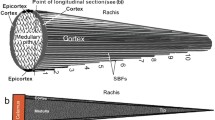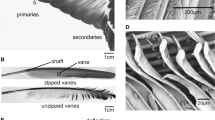Abstract
Millions of years of biological evolution have produced efficient materials and structures that are a source of inspiration to engineers. The paper reviews the overall design principles in the feather rachis and elaborates upon recent functional interpretations. It concentrates on recent findings that shed new light on feather microstructure and on how keratin fibres in a protein matrix are arranged in intricate ways to achieve specific combinations of stiffness and strength on the one hand and flexibility and elasticity on the other. This includes the syncitial barbule cells of the rachis and barb cortex, the crossed-fibre architecture of the epicortex (lateral walls of the cortex), and the foam-like structure of the medullary pith. Discussion of the biomechanics of feather microstructure uses engineering principles for a better understanding of the functional ramifications. Further research is proposed with respect to feather micro- and macrostructure in trying to expand our knowledge on bird flight, behaviour and ecology in different species. The discussion also considers the validity of a study purporting to use quantitative methods and engineering principles to show that the iconic fossil bird Archaeopteryx was incapable of flapping flight.
Zusammenfassung
Federstruktur, Biomechanik und Bionik: die unglaubliche Leichtigkeit des Seins
Im Laufe von Jahrmillionen sind durch biologische Evolution leistungsfähige Materialien und Strukturen entstanden, die für Ingenieure eine Quelle der Inspiration darstellen. Diese Arbeit fasst die allgemeinen mikrostrukturellen Bauprinzipien des Federschaftes zusammen und geht ausführlicher auf neuere funktionelle Deutungen ein. Der Schwerpunkt liegt dabei auf jüngeren Erkenntnissen, die ein neues Licht auf die Mikrostruktur der Feder werfen und darauf, wie Keratinfasern in einer Proteinmatrix auf komplexe Art angeordnet sind, um bestimmte Konstellationen von Starrheit und Festigkeit einerseits und Biegsamkeit und Elastizität andererseits zu erreichen. Dies umfasst auch die synzytialen Strahlzellen des Cortex von Federschaft und Federästen und die aus überkreuzten Fasern bestehende Bauweise des Epicortex (die seitlichen Wände des Cortex) sowie die schaumstoffähnliche Struktur des Marks. Für ein besseres Verständnis der funktionalen Verzweigungen diskutieren wir die Biomechanik der Federmikrostruktur anhand von bautechnischen Prinzipien. Wir empfehlen weitere Forschung bezüglich der Mikro- und Makrostruktur von Federn, um unser Wissen über den Vogelflug, das Verhalten und die Ökologie verschiedener Arten zu erweitern. In der Diskussion prüfen wir ebenfalls die Aussagekraft einer Studie, welche angibt, mittels quantitativer Methoden und Prinzipien aus der Bautechnik zeigen zu können, dass der legendäre fossile Vogel Archaeopteryx nicht zum Schlagflug befähigt war.










Similar content being viewed by others
References
Alibardi L (2002) Keratinization and lipogenesis in epidermal derivatives of the zebrafinch Taeniopygia guttata castanotis (Aves, Passeriformes, Ploecidae) during embryonic development. J Morphol 251:294–308
Alibardi L (2007a) Cell organization of barb ridges in regenerating feathers of the quail: implications of the elongation of barb ridges for the evolution and diversification of feathers. Acta Zool (Stockholm) 88:101–117
Alibardi L (2007b) Wedge cells during regeneration of juvenile and adult feathers and their role in carving out the branching patterns of barbs. Ann Anat 189:234–242
Alibardi L, Toni M (2008) Cytochemical and molecular characteristics of the process of cornification during feather morphogenesis. Prog Histochem Cytochem 43:1–69
Amada S, Lakes RS (1997) Viscoelastic properties of bamboo. J Mater Sci 32:2693–2697
Ashby MF, Gibson LJ, Wegst U, Olive R (1995) The mechanical properties of natural materials. Proc Math Phys Sci 450(1938):123–140
Bachmann T, Klän S, Baumgartner W, Klaas M, Schröder W, Wagner H (2007) Morphometric characterisation of wing feathers of the barn owl Tyto alba pratincola and the pigeon Columba livia. Front Zool 4:23. doi:10.1186/1742-9994-4-23
Bodde SG, Meyers MA, McKittrick J (2011) Correlation of the mechanical and structural properties of cortical rachis keratin of the retrices of the Toco Toucan (Ramphastos toco). J Mech Behav Biomed Mater. doi:10.1016/j.jmbbm.2011.01.010
Bonser RHC (2001) The mechanical performance of medulloid foam from feathers. J Mater Sci Lett 20:941–942
Bonser RHC, Purslow PP (1995) The Young’s modulus of feather keratin. J Exp Biol 198:1029–1033
Chandler AC (1916) A study of the structure of feathers with reference to their taxonomic significance. Univ Calif Publ Zool 13:243–446
Clark CJ (2009) Courtship dives of Anna’s hummingbird offer insights into flight performance limits. Proc R Soc Lond B. doi:10.1098/rspb.2009.0508
Corning WR, Biewener AA (1998) In vivo strains in pigeon flight feather shafts: implications for structural design. J Exp Biol 201:3057–3065
Dawson MA, Gibson LJ (2006) Biomimetics: extending nature’s design of thin wall shells with cellular cores. Press WIT Transactions on Ecology and the Environment, vol 87. WIT, Southampton
Douglas RA (1963) Introduction to solid mechanics. Wadsworth, Belmont
Ennos AR, Casteren A van (2010) Transverse stresses and modes of failure in tree branches and other beams. Proc R Soc Lond B 277:1253–1258. doi:10.1098/rspb.2009.2093
Erb RM, Libanori R, Rothfuchs N, Studart AR (2012) Composites reinforced in three dimensions by using low magnetic fields. Science 335:199
Feduccia A (2012) Riddle of the feathered dragons: hidden birds of China. Yale University Press, New Haven
Filshie BK, Rogers GE (1962) An electron microscope study of the fine structure of feather keratin. J Cell Biol 13(1):1–12
Fraser RDB, Parry DAD (2008) Molecular packing in the feather keratin filament. J Struct Biol 162:1–13. doi:10.1016/j.jsb.2008.01.011
Fraser RDB, Parry DAD (2011) The structural basis of the filament-matrix texture in the avian/reptilian group of hard b-keratins. J Struct Biol 173:391–405
Fratzl P, Weinkamer R (2007) Nature’s hierarchical materials. Prog Mater Sci 52:1263–1334
Gibson LJ (2012) The hierarchical structure and mechanics of plant materials. J R Soc Interface. doi:10.1098/rsif.2012.0341
Gibson LJ, Ashby MF (1999) Cellular solids, structure and properties, 2nd edn. Cambridge University Press, Cambridge
Goodfellow B (2004) Design and application of a fiber pullout test for examining controlled interfaces in fiber reinforced polymers. NNIN REU Research Accomplishments, pp 62–63
Gordon JE (1978) Structures. Penguin, Harmondsworth
Karam GN, Gibson LJ (1995) Elastic buckling of cylindrical shells with elastic cores—i. analysis. Int J Solids Struct 32(8/9): 1259–1283
Katti KS, Katti DR (2006) Why is nacre so tough and strong? Mater Sci Eng C 26:1317–1324
Lakes RS, Swan C, Garner E, Lee T, Stewart K (1999) Synthesis in bio-solid mechanics. In: Pedersen P, Bendsøe M (eds) IUTAM, solid mechanics and its applications, vol 69. Kluwer, Dordrecht, pp 1–10
Lingham-Soliar T (2005a) Dorsal fin in the white shark, Carcharodon carcharias: a dynamic stabilizer for fast swimming. J Morphol 263:1–11
Lingham-Soliar T (2005b) Caudal fin in the white shark, Carcharodon carcharias (Lamnidae): a dynamic propeller for fast, efficient swimming. J Morphol 264:233–252. doi:10.1002/jmor.10328
Lingham-Soliar T, Murugan N (2013) A new helical crossed-fibre structure of b-Keratin in flight feathers and its biomechanical implications. Plos ONE 8(6):1–12 (e65849)
Lingham-Soliar T, Bonser RHC, Wesley-Smith J (2010) Selective biodegradation of keratin matrix in feather rachis reveals classic bioengineering. Proc R Soc Lond B 277:1161–1168. doi:10.1098/rspb.2009.1980
Lucas AM, Stettenheim PR (1972) Avian anatomy—the integument, vols 1 and 2. U.S. Government Printing Office, Washington DC, 1972
Maderson PFA, Hillenius WJ, Hiller U, Dove CC (2009) Towards a comprehensive model of feather regeneration. J Morphol. doi:10.1002/jmor.10747
McKinnon AJ (2006) The self-assembly of keratin intermediate filaments into macrofibrils: is this process mediated by a mesophase? Curr Appl Phys 6:375–378
Meyers MA, Lin AYM, Seki Y, Chen P-Y, Kad BK et al (2003) Structural biological composites: an overview. JOM (July): 36–43
Meyers MA, McKittrick J, Chen P-U (2013) Structural biological materials: critical mechanics-materials connections. Science 339:773. doi:10.1126/science.1220854
Munch E, Launey ME, Alsem DH, Saiz E, Tomsia AP, Ritchie RO (2008) Tough, bio-inspired hybrid materials. Science 322:1516
Naraghi M, Filleter T, Moravsky A, Locascio M, Loutfy RO, Espinosa HD (2010) A multiscale study of high performance double-walled nanotube—polymer fibres. ACS Nano. doi:10.1021/nn101404u (101026144939060)
Nudds RL, Dyke GJ (2010a) Narrow primary feather rachises in Confuciusornis and Archaeopteryx suggest poor flight ability. Science 328:887. doi:10.1126/science.1188895
Nudds RL, Dyke GJ (2010b) Response to comments on “Primary Feather Rachises in Confuciusornis and Archaeopteryx Suggest Poor Flight Ability”. Science 330:320. doi:10.1126/science.1193474
Pabst A (1996) Springs in swimming animals. Am Zool 36(6):723–735. doi:10.1093/icb/36.6.723
Paul GS (2010) Comment on “Narrow Primary Feather Rachises in Confuciusorni and Archaeopteryx Suggest Poor Flight Ability”. Science 330:320. doi:10.1126/science.1192963
Purslow PP, Vincent JFV (1978) Mechanical properties of primary feathers from the pigeon. J Exp Biol 72:251–260
Santos PMD, Julio ENBS, Silva VD (2007) Correlation between concrete-to-concrete bond strength and the roughness of the substrate surface. Constr Build Mater 21:1688–1695
Sawyer RH, Knapp LW (2003) Avian skin development and the evolutionary origin of feathers. J Exp Zool (Mol Dev Evol) 298B:57–72
Song F, Bai Y (2001) Analysis of the strengthening and toughening of a biomaterial interface. Sci China Ser A 44(12):1596–1601. doi:10.1007/BF02880799
Stettenheim PR (2000) The integumentary morphology of modern birds–an overview. Am Zool 40:461–477
Vincent JFV, Owers P (1986) Mechanical design of hedgehog spines and porcupine quills. J Zool Lond (A) 210:55–75
Wainwright SA, Biggs WD, Currey JD, Gosline JM (1976) Mechanical design in organisms. Edward Arnold, London
Wainwright SA, Vosburgh F, Hebrank JH (1978) Shark skin: function in locomotion. Science 202:747–749
Wegst UGK, Ashby M (2004) The mechanical efficiency of natural materials. Philos Mag 84:2167–2181
Weiss IM, Kirchner HOK (2010) The peacock’s train (Pavo cristatus and Pavo cristatus mut. alba) I. Structure, mechanics, and chemistry of the tail feather coverts. J Exp Zool 313A:690–703
Acknowledgments
I thank the four anonymous referees for their valuable comments.
Author information
Authors and Affiliations
Corresponding author
Additional information
Communicated by F. Bairlein.
Electronic supplementary material
10336_2013_1038_MOESM1_ESM.jpg
SI Figure 1. Unstressed rachis. The section shows varying diameters of the syncitial barbule cells depending on whether they are transected closer to the nodes or further away because of staggering of the syncitial barbule cells along the rachis length. At least two syncitial barbule cells can be seen (white arrows), the lower one given its size is probably transected at its widest point. Scale bar = 1 μm. (JPEG 37 kb)
Rights and permissions
About this article
Cite this article
Lingham-Soliar, T. Feather structure, biomechanics and biomimetics: the incredible lightness of being. J Ornithol 155, 323–336 (2014). https://doi.org/10.1007/s10336-013-1038-0
Received:
Revised:
Accepted:
Published:
Issue Date:
DOI: https://doi.org/10.1007/s10336-013-1038-0




